北师大版(2019)必修第三册Unit 8 Green Living 语法知识点课件(共21张PPT)
文档属性
| 名称 | 北师大版(2019)必修第三册Unit 8 Green Living 语法知识点课件(共21张PPT) |  | |
| 格式 | pptx | ||
| 文件大小 | 1.4MB | ||
| 资源类型 | 教案 | ||
| 版本资源 | 北师大版(2019) | ||
| 科目 | 英语 | ||
| 更新时间 | 2024-04-14 19:54:27 | ||
图片预览

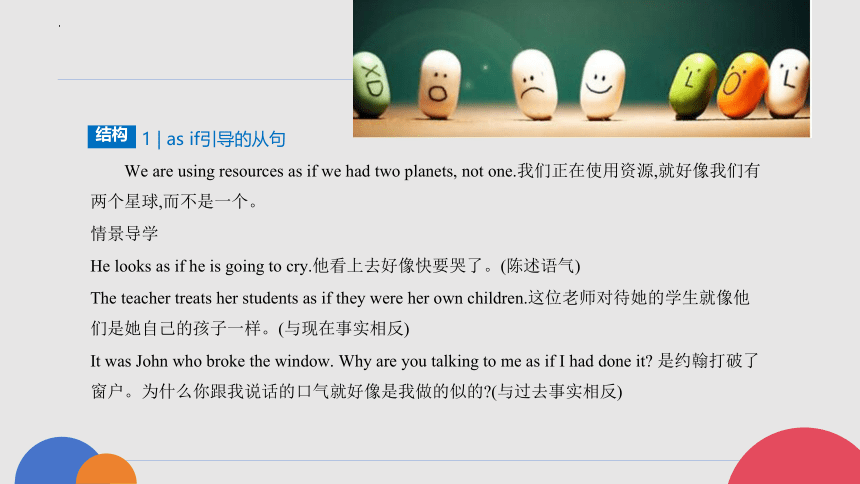

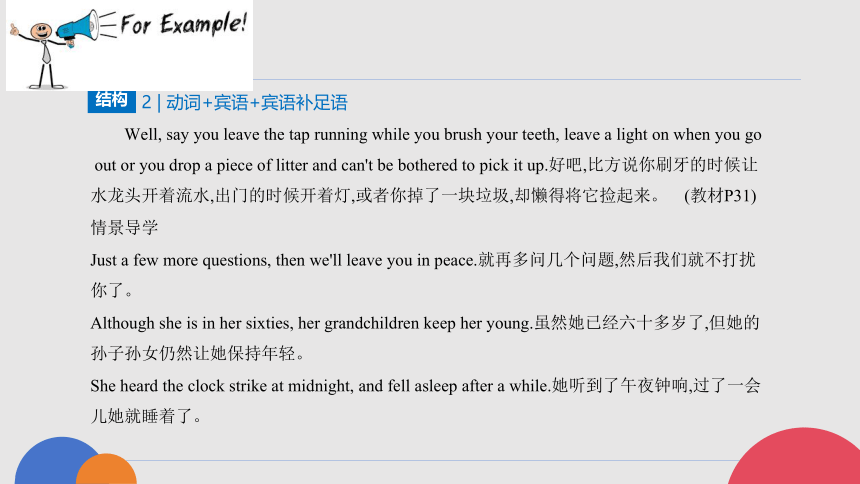
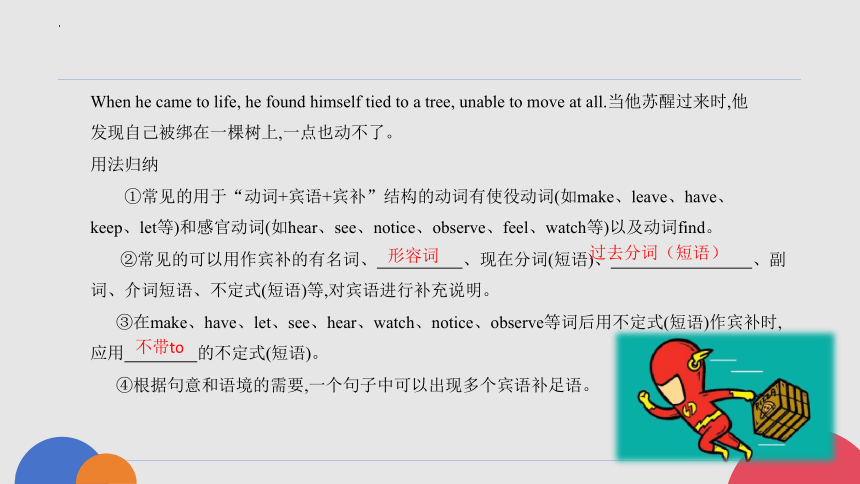

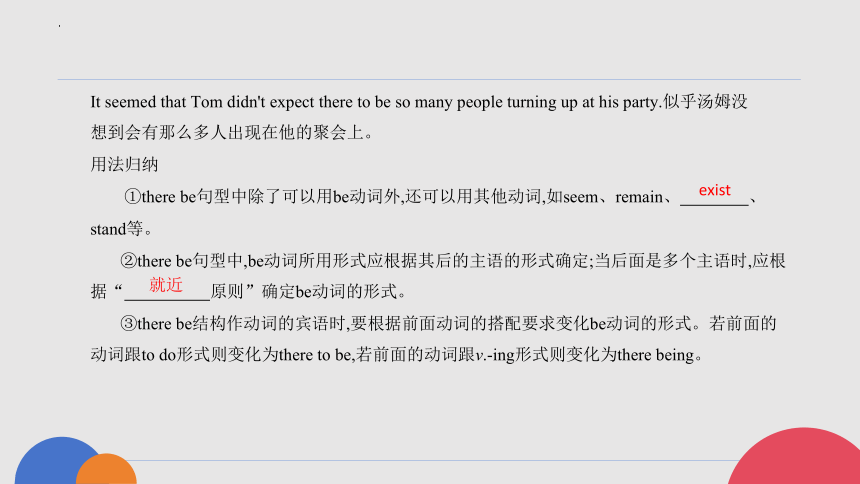

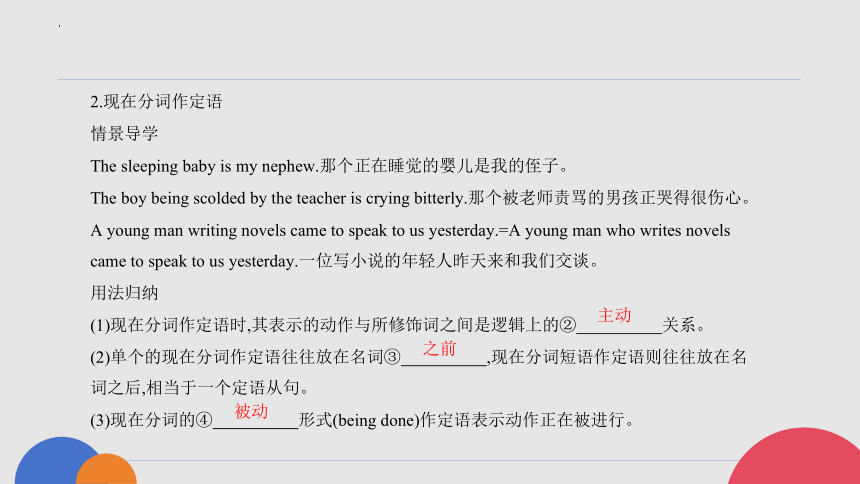
文档简介
(共21张PPT)
Unit 8 语法知识精讲
1 | as if引导的从句
We are using resources as if we had two planets, not one.我们正在使用资源,就好像我们有
两个星球,而不是一个。
情景导学
He looks as if he is going to cry.他看上去好像快要哭了。(陈述语气)
The teacher treats her students as if they were her own children.这位老师对待她的学生就像他
们是她自己的孩子一样。(与现在事实相反)
It was John who broke the window. Why are you talking to me as if I had done it 是约翰打破了
窗户。为什么你跟我说话的口气就好像是我做的似的 (与过去事实相反)
结构
He keeps talking, as if he would never stop.他一直在说,就好像永远不会停了似的。(与将来事
实相反)
用法归纳
as if=as though意为“似乎,好像”,常引导状语从句或表语从句。
(1)如果as if/though引导的从句表示的情况是真实的或极有可能发生,从句要用陈述语气。
(2)如果as if/though引导的从句只是表示一种假设的情况,从句要用虚拟语气,其形式如下:
①表示与现在事实相反的假设,从句谓语用 (从句中be动词常用were);
②表示与过去事实相反的假设,从句谓语用 ;
③表示与将来事实相反的假设,从句谓语用“would/could/might+动词原形”的形式。
一般过去时
过去完成时
2 | 动词+宾语+宾语补足语
Well, say you leave the tap running while you brush your teeth, leave a light on when you go
out or you drop a piece of litter and can't be bothered to pick it up.好吧,比方说你刷牙的时候让
水龙头开着流水,出门的时候开着灯,或者你掉了一块垃圾,却懒得将它捡起来。 (教材P31)
情景导学
Just a few more questions, then we'll leave you in peace.就再多问几个问题,然后我们就不打扰
你了。
Although she is in her sixties, her grandchildren keep her young.虽然她已经六十多岁了,但她的
孙子孙女仍然让她保持年轻。
She heard the clock strike at midnight, and fell asleep after a while.她听到了午夜钟响,过了一会
儿她就睡着了。
结构
When he came to life, he found himself tied to a tree, unable to move at all.当他苏醒过来时,他
发现自己被绑在一棵树上,一点也动不了。
用法归纳
①常见的用于“动词+宾语+宾补”结构的动词有使役动词(如make、leave、have、
keep、let等)和感官动词(如hear、see、notice、observe、feel、watch等)以及动词find。
②常见的可以用作宾补的有名词、 、现在分词(短语)、 、副
词、介词短语、不定式(短语)等,对宾语进行补充说明。
③在make、have、let、see、hear、watch、notice、observe等词后用不定式(短语)作宾补时,
应用 的不定式(短语)。
④根据句意和语境的需要,一个句子中可以出现多个宾语补足语。
形容词
过去分词(短语)
不带to
3 | there be句型
Although there seemed only a slim chance that the trees could survive, the difficulty did not
prevent her from trying.虽然看起来这些树能活下来的可能性很小,但困难并没有阻止她尝
试。 (教材P109)
情景导学
There is a pot and several piles of papers lying randomly on the desk.有一个罐子和几摞文件随
意地放在桌子上。
Though we have solved so many problems, there always seem new problems to occur.虽然我们
已经解决了这么多问题,但是似乎总会有新的问题出现。
There still exist some difficult problems in dispute, which need further discussion.仍存在一些在
争议中的难题,需要进一步探讨。
结构
It seemed that Tom didn't expect there to be so many people turning up at his party.似乎汤姆没
想到会有那么多人出现在他的聚会上。
用法归纳
①there be句型中除了可以用be动词外,还可以用其他动词,如seem、remain、 、
stand等。
②there be句型中,be动词所用形式应根据其后的主语的形式确定;当后面是多个主语时,应根
据“ 原则”确定be动词的形式。
③there be结构作动词的宾语时,要根据前面动词的搭配要求变化be动词的形式。若前面的
动词跟to do形式则变化为there to be,若前面的动词跟v.-ing形式则变化为there being。
exist
就近
一、现在分词
1.现在分词作表语
情景导学
The result of the game was disappointing.比赛的结果令人失望。
The movie was so exciting that I didn't sleep all night.这部电影真令人激动,以至于我整晚都没
有睡觉。
用法归纳
作表语的现在分词往往具有形容词的性质,说明① 的性质或特征。这类词有
“令人……的”的含义,常修饰事或物。
主语
动词-ing和-ed形式
2.现在分词作定语
情景导学
The sleeping baby is my nephew.那个正在睡觉的婴儿是我的侄子。
The boy being scolded by the teacher is crying bitterly.那个被老师责骂的男孩正哭得很伤心。
A young man writing novels came to speak to us yesterday.=A young man who writes novels
came to speak to us yesterday.一位写小说的年轻人昨天来和我们交谈。
用法归纳
(1)现在分词作定语时,其表示的动作与所修饰词之间是逻辑上的② 关系。
(2)单个的现在分词作定语往往放在名词③ ,现在分词短语作定语则往往放在名
词之后,相当于一个定语从句。
(3)现在分词的④ 形式(being done)作定语表示动作正在被进行。
主动
之前
被动
3.现在分词作宾语补足语
情景导学
I heard Susan singing in her room.我听到苏珊在她的房间里唱歌。
I wouldn't have you running about in the room.我不允许你在房间里跑来跑去。
用法归纳
现在分词作宾语补足语时,其表示的动作与宾语之间是逻辑上的⑤ 关系。
4.现在分词作状语
情景导学
Hearing the noise, I turned round.=When I heard the noise, I turned round.听到响声,我转过身
去。
Working hard, you'll succeed.=If you work hard, you'll succeed.如果你努力工作,你会成功的。
主动
Being too young, he couldn't join the army.=Because he was too young, he couldn't join the army.
因为太年轻,他不能参军。
He walked down the river, heading for home.=He walked down the river and headed for home.他
沿着河流,向家走去。
Not having been invited to the party, she had to stay home.由于没有被邀请参加聚会,她只好待
在家里。
用法归纳
(1)现在分词(短语)作状语时,其所表示的动作与句子主语之间为逻辑上的⑥ 关
系。
(2)现在分词(短语)作状语常常用来表示时间、⑦ 、条件、伴随、结果等,可以转
换成状语从句,或者由⑧ 或but连接的并列分句。
主动
原因
and
(3)现在分词(短语)作状语,其否定形式是在前面加⑨ 。
特别提醒
现在分词作状语时,其逻辑主语必须与句子的主语一致。
Living in the big city, she can get easy access to places like shops and restaurants.(√)
Living in the big city, access to places like shops and restaurants is easy to get.(×)
not
二、过去分词
1.过去分词作表语
情景导学
They are all deeply moved by the old man's story.他们都被那位老人的故事深深地打动了。
Please remain seated until all the lights are on.请坐好,直到灯全部亮起为止。
用法归纳
过去分词作表语时一般位于⑩ (如be、become、remain、look、feel、seem
等)之后,多表示主语所处的状态,此时的过去分词大多已形容词化。
2.过去分词作定语
情景导学
The injured passengers were sent to hospital quickly.受伤的乘客被迅速送往了医院。
系动词
The evidence found by this policeman proved Tom innocent.=The evidence which was found by
the policeman proved Tom innocent.这个警察发现的证据证明汤姆是无辜的。
The plan put forward at the meeting will be carried out soon.会议上提出的计划很快就会实
施。(表示被动和完成)
Our retired soccer coach went to watch us play the game last week.我们已经退休的足球教练上
周去看了我们的比赛。(表示完成)
用法归纳
(1)一般情况下,单个过去分词作前置定语,即放在被修饰词之前;过去分词短语作定语时往往
作 定语,即放在被修饰词 ,它的作用相当于一个定语从句。
(2)及物动词的过去分词作定语往往表示被动和完成;不及物动词的过去分词作定语不表示
,只表示 。
后置
之后
被动
完成
3.过去分词作宾语补足语
情景导学
People are glad to see the problems solved within seven days.人们很高兴看到问题在七天内得
到了解决。
They found all the guests gone when they woke up.他们醒来时发现所有的客人都走了。
用法归纳
(1)及物动词的过去分词作宾语补足语时,其所表示的动作与宾语之间为逻辑上的
关系,表示被动或已完成,有时两者兼有。
(2)不及物动词的过去分词作宾语补足语时,不表示被动,只表示宾语的性质或状态。
被动
4.过去分词作状语
情景导学
Seriously injured, she was sent to hospital at once.=Because she was seriously injured, she was
sent to hospital at once.由于受伤严重,她被立刻送往医院了。
Used with care, one tin will last for six weeks.=If it is used with care, one tin will last for six
weeks.如果小心使用的话,一罐能持续六周。
The old man walked into the room, supported by his son.这个老人在儿子的搀扶下走进了房
间。
用法归纳
过去分词(短语)作状语,可以表示时间、原因、条件、方式或伴随等,相当于一个状语从
句,其逻辑主语通常为句子的主语,且与句子的主语之间构成逻辑上的 关系。
被动
动词还是名词
英语中有些词既可以作名词,又可以作动词,灵活地使用这些词会让我们的表达灵活多样,更
加地道。
1.表示动物的名词作动词
情景导学
If you keep dogging me, I will call the police.如果你再尾随我,我就报警了。
The river snakes its way through the wood.这条河蜿蜒流过树林。
I got up late this morning, so I had to wolf my breakfast to avoid being late for class.我今天早上
起床晚了,所以我不得不狼吞虎咽地吃早餐,以免上课迟到。
用法归纳
表示动物的名词用作动词时通常都具有该动物的某种① 。
习性
2.表示人的名词作动词
情景导学
She always likes to boss people around.她总是喜欢对周围的人发号施令。
He worked in a hospital for ten years nursing cancer patients.他在一家医院工作了十年,护理癌
症患者。
Don't baby your kids. It won't benefit them in the long run.不要把你的孩子当婴儿般照顾。 从
长远来看,这对他们没有好处。
用法归纳
关于人的名词用作动词时通常都具有该身份的人的② 特征。
形象
3.表示身体部位的名词作动词
情景导学
Will you hand me the pencil please 请把铅笔递给我好吗
You need to skin the potatoes before cooking them.煮土豆前你得先去皮。
When passing by the shop window, she eyed a very beautiful gold ring.经过商店橱窗时,她注视
着一枚非常漂亮的金戒指。
用法归纳
表示身体部位的名词用作动词时表达的意思通常都与这些部位的③ 相关。
功能
即时巩固
单句语法填空
1.Inspired by the Belt and Road Forum for International Cooperation
(hold) in Beijing, Cao decided to cover the route by hiking as a tribute(致敬) to the ancient Silk
Road.
2.It can help to build a community with a (share) future for mankind.
3.The event included a number of public promotional activities on social media,
(invite) twenty-nine tea professionals from around the world to have thirty-six hours of
uninterrupted live broadcasts.
4.One theory, increasingly (support) by experts, suggests that smell pref-
erences are learned.
held
shared
inviting
supported
5. (cover) an area about three times the size of Yellowstone Na-
tional Park, the GPNP will be one of the first national parks in the country.
6.Henry ran one hundred metres, jumped over a 1.2-metre fence, and held
out his arms to catch the (fall) child.
7.The city temperatures have returned from record low to normal, (allow)
the citizens to enjoy the outdoors again.
8.When I got home, I saw my mother (cook) supper.
9.Hearing the (excite) news, we all felt very (excite).
10.When we entered our classroom, we found the classroom (clean) by Jim.
Covering
falling
allowing
cooking
exciting
excited
cleaned
Unit 8 语法知识精讲
1 | as if引导的从句
We are using resources as if we had two planets, not one.我们正在使用资源,就好像我们有
两个星球,而不是一个。
情景导学
He looks as if he is going to cry.他看上去好像快要哭了。(陈述语气)
The teacher treats her students as if they were her own children.这位老师对待她的学生就像他
们是她自己的孩子一样。(与现在事实相反)
It was John who broke the window. Why are you talking to me as if I had done it 是约翰打破了
窗户。为什么你跟我说话的口气就好像是我做的似的 (与过去事实相反)
结构
He keeps talking, as if he would never stop.他一直在说,就好像永远不会停了似的。(与将来事
实相反)
用法归纳
as if=as though意为“似乎,好像”,常引导状语从句或表语从句。
(1)如果as if/though引导的从句表示的情况是真实的或极有可能发生,从句要用陈述语气。
(2)如果as if/though引导的从句只是表示一种假设的情况,从句要用虚拟语气,其形式如下:
①表示与现在事实相反的假设,从句谓语用 (从句中be动词常用were);
②表示与过去事实相反的假设,从句谓语用 ;
③表示与将来事实相反的假设,从句谓语用“would/could/might+动词原形”的形式。
一般过去时
过去完成时
2 | 动词+宾语+宾语补足语
Well, say you leave the tap running while you brush your teeth, leave a light on when you go
out or you drop a piece of litter and can't be bothered to pick it up.好吧,比方说你刷牙的时候让
水龙头开着流水,出门的时候开着灯,或者你掉了一块垃圾,却懒得将它捡起来。 (教材P31)
情景导学
Just a few more questions, then we'll leave you in peace.就再多问几个问题,然后我们就不打扰
你了。
Although she is in her sixties, her grandchildren keep her young.虽然她已经六十多岁了,但她的
孙子孙女仍然让她保持年轻。
She heard the clock strike at midnight, and fell asleep after a while.她听到了午夜钟响,过了一会
儿她就睡着了。
结构
When he came to life, he found himself tied to a tree, unable to move at all.当他苏醒过来时,他
发现自己被绑在一棵树上,一点也动不了。
用法归纳
①常见的用于“动词+宾语+宾补”结构的动词有使役动词(如make、leave、have、
keep、let等)和感官动词(如hear、see、notice、observe、feel、watch等)以及动词find。
②常见的可以用作宾补的有名词、 、现在分词(短语)、 、副
词、介词短语、不定式(短语)等,对宾语进行补充说明。
③在make、have、let、see、hear、watch、notice、observe等词后用不定式(短语)作宾补时,
应用 的不定式(短语)。
④根据句意和语境的需要,一个句子中可以出现多个宾语补足语。
形容词
过去分词(短语)
不带to
3 | there be句型
Although there seemed only a slim chance that the trees could survive, the difficulty did not
prevent her from trying.虽然看起来这些树能活下来的可能性很小,但困难并没有阻止她尝
试。 (教材P109)
情景导学
There is a pot and several piles of papers lying randomly on the desk.有一个罐子和几摞文件随
意地放在桌子上。
Though we have solved so many problems, there always seem new problems to occur.虽然我们
已经解决了这么多问题,但是似乎总会有新的问题出现。
There still exist some difficult problems in dispute, which need further discussion.仍存在一些在
争议中的难题,需要进一步探讨。
结构
It seemed that Tom didn't expect there to be so many people turning up at his party.似乎汤姆没
想到会有那么多人出现在他的聚会上。
用法归纳
①there be句型中除了可以用be动词外,还可以用其他动词,如seem、remain、 、
stand等。
②there be句型中,be动词所用形式应根据其后的主语的形式确定;当后面是多个主语时,应根
据“ 原则”确定be动词的形式。
③there be结构作动词的宾语时,要根据前面动词的搭配要求变化be动词的形式。若前面的
动词跟to do形式则变化为there to be,若前面的动词跟v.-ing形式则变化为there being。
exist
就近
一、现在分词
1.现在分词作表语
情景导学
The result of the game was disappointing.比赛的结果令人失望。
The movie was so exciting that I didn't sleep all night.这部电影真令人激动,以至于我整晚都没
有睡觉。
用法归纳
作表语的现在分词往往具有形容词的性质,说明① 的性质或特征。这类词有
“令人……的”的含义,常修饰事或物。
主语
动词-ing和-ed形式
2.现在分词作定语
情景导学
The sleeping baby is my nephew.那个正在睡觉的婴儿是我的侄子。
The boy being scolded by the teacher is crying bitterly.那个被老师责骂的男孩正哭得很伤心。
A young man writing novels came to speak to us yesterday.=A young man who writes novels
came to speak to us yesterday.一位写小说的年轻人昨天来和我们交谈。
用法归纳
(1)现在分词作定语时,其表示的动作与所修饰词之间是逻辑上的② 关系。
(2)单个的现在分词作定语往往放在名词③ ,现在分词短语作定语则往往放在名
词之后,相当于一个定语从句。
(3)现在分词的④ 形式(being done)作定语表示动作正在被进行。
主动
之前
被动
3.现在分词作宾语补足语
情景导学
I heard Susan singing in her room.我听到苏珊在她的房间里唱歌。
I wouldn't have you running about in the room.我不允许你在房间里跑来跑去。
用法归纳
现在分词作宾语补足语时,其表示的动作与宾语之间是逻辑上的⑤ 关系。
4.现在分词作状语
情景导学
Hearing the noise, I turned round.=When I heard the noise, I turned round.听到响声,我转过身
去。
Working hard, you'll succeed.=If you work hard, you'll succeed.如果你努力工作,你会成功的。
主动
Being too young, he couldn't join the army.=Because he was too young, he couldn't join the army.
因为太年轻,他不能参军。
He walked down the river, heading for home.=He walked down the river and headed for home.他
沿着河流,向家走去。
Not having been invited to the party, she had to stay home.由于没有被邀请参加聚会,她只好待
在家里。
用法归纳
(1)现在分词(短语)作状语时,其所表示的动作与句子主语之间为逻辑上的⑥ 关
系。
(2)现在分词(短语)作状语常常用来表示时间、⑦ 、条件、伴随、结果等,可以转
换成状语从句,或者由⑧ 或but连接的并列分句。
主动
原因
and
(3)现在分词(短语)作状语,其否定形式是在前面加⑨ 。
特别提醒
现在分词作状语时,其逻辑主语必须与句子的主语一致。
Living in the big city, she can get easy access to places like shops and restaurants.(√)
Living in the big city, access to places like shops and restaurants is easy to get.(×)
not
二、过去分词
1.过去分词作表语
情景导学
They are all deeply moved by the old man's story.他们都被那位老人的故事深深地打动了。
Please remain seated until all the lights are on.请坐好,直到灯全部亮起为止。
用法归纳
过去分词作表语时一般位于⑩ (如be、become、remain、look、feel、seem
等)之后,多表示主语所处的状态,此时的过去分词大多已形容词化。
2.过去分词作定语
情景导学
The injured passengers were sent to hospital quickly.受伤的乘客被迅速送往了医院。
系动词
The evidence found by this policeman proved Tom innocent.=The evidence which was found by
the policeman proved Tom innocent.这个警察发现的证据证明汤姆是无辜的。
The plan put forward at the meeting will be carried out soon.会议上提出的计划很快就会实
施。(表示被动和完成)
Our retired soccer coach went to watch us play the game last week.我们已经退休的足球教练上
周去看了我们的比赛。(表示完成)
用法归纳
(1)一般情况下,单个过去分词作前置定语,即放在被修饰词之前;过去分词短语作定语时往往
作 定语,即放在被修饰词 ,它的作用相当于一个定语从句。
(2)及物动词的过去分词作定语往往表示被动和完成;不及物动词的过去分词作定语不表示
,只表示 。
后置
之后
被动
完成
3.过去分词作宾语补足语
情景导学
People are glad to see the problems solved within seven days.人们很高兴看到问题在七天内得
到了解决。
They found all the guests gone when they woke up.他们醒来时发现所有的客人都走了。
用法归纳
(1)及物动词的过去分词作宾语补足语时,其所表示的动作与宾语之间为逻辑上的
关系,表示被动或已完成,有时两者兼有。
(2)不及物动词的过去分词作宾语补足语时,不表示被动,只表示宾语的性质或状态。
被动
4.过去分词作状语
情景导学
Seriously injured, she was sent to hospital at once.=Because she was seriously injured, she was
sent to hospital at once.由于受伤严重,她被立刻送往医院了。
Used with care, one tin will last for six weeks.=If it is used with care, one tin will last for six
weeks.如果小心使用的话,一罐能持续六周。
The old man walked into the room, supported by his son.这个老人在儿子的搀扶下走进了房
间。
用法归纳
过去分词(短语)作状语,可以表示时间、原因、条件、方式或伴随等,相当于一个状语从
句,其逻辑主语通常为句子的主语,且与句子的主语之间构成逻辑上的 关系。
被动
动词还是名词
英语中有些词既可以作名词,又可以作动词,灵活地使用这些词会让我们的表达灵活多样,更
加地道。
1.表示动物的名词作动词
情景导学
If you keep dogging me, I will call the police.如果你再尾随我,我就报警了。
The river snakes its way through the wood.这条河蜿蜒流过树林。
I got up late this morning, so I had to wolf my breakfast to avoid being late for class.我今天早上
起床晚了,所以我不得不狼吞虎咽地吃早餐,以免上课迟到。
用法归纳
表示动物的名词用作动词时通常都具有该动物的某种① 。
习性
2.表示人的名词作动词
情景导学
She always likes to boss people around.她总是喜欢对周围的人发号施令。
He worked in a hospital for ten years nursing cancer patients.他在一家医院工作了十年,护理癌
症患者。
Don't baby your kids. It won't benefit them in the long run.不要把你的孩子当婴儿般照顾。 从
长远来看,这对他们没有好处。
用法归纳
关于人的名词用作动词时通常都具有该身份的人的② 特征。
形象
3.表示身体部位的名词作动词
情景导学
Will you hand me the pencil please 请把铅笔递给我好吗
You need to skin the potatoes before cooking them.煮土豆前你得先去皮。
When passing by the shop window, she eyed a very beautiful gold ring.经过商店橱窗时,她注视
着一枚非常漂亮的金戒指。
用法归纳
表示身体部位的名词用作动词时表达的意思通常都与这些部位的③ 相关。
功能
即时巩固
单句语法填空
1.Inspired by the Belt and Road Forum for International Cooperation
(hold) in Beijing, Cao decided to cover the route by hiking as a tribute(致敬) to the ancient Silk
Road.
2.It can help to build a community with a (share) future for mankind.
3.The event included a number of public promotional activities on social media,
(invite) twenty-nine tea professionals from around the world to have thirty-six hours of
uninterrupted live broadcasts.
4.One theory, increasingly (support) by experts, suggests that smell pref-
erences are learned.
held
shared
inviting
supported
5. (cover) an area about three times the size of Yellowstone Na-
tional Park, the GPNP will be one of the first national parks in the country.
6.Henry ran one hundred metres, jumped over a 1.2-metre fence, and held
out his arms to catch the (fall) child.
7.The city temperatures have returned from record low to normal, (allow)
the citizens to enjoy the outdoors again.
8.When I got home, I saw my mother (cook) supper.
9.Hearing the (excite) news, we all felt very (excite).
10.When we entered our classroom, we found the classroom (clean) by Jim.
Covering
falling
allowing
cooking
exciting
excited
cleaned
同课章节目录
